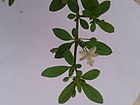Note: This is a project under development. The articles on this wiki are just being initiated and broadly incomplete. You can Help creating new pages.
Mollugo cerviana
Mollugo cerviana is a species of flowering plant known by the common name threadstem carpetweed. It can be found on most continents growing as a weed in many types of dry, sandy habitat types.
Uses
Parts Used
Chemical Composition
Plant contains flavone-c-glycoside orientin, vitexin. Use - Stomachic, aperient and antiseptic. Flower and tender shoots diaphoretic and febrifuge. Root boiled in oil for application in gout and rheumatism. [1]
Common names
| Language | Common name |
|---|---|
| Kannada | kaage purale gida, kaage purule gida, kage purale gida, parpaataka gida, parpataka |
| Hindi | chirimorio, chiriya ro khet, jima, parpat, taph-jhad |
| Malayalam | parpataka |
| Tamil | citalacatti2, citam, citam2, citappiriyan, cukkumapattiri, cutcumapattiri, kilavankuti, kirismacuntarakam, kolanti, kottamakantakam, kucattinpati2, kuccakam2 |
| Telugu | parpaataka, parpadagum, parpataka, parpatakamu, pichhu kaalu, verri chatarasi |
| Marathi | NA |
| Gujarathi | NA |
| Punjabi | NA |
| Kashmiri | NA |
| Sanskrit | grishmasundara, parpataka, phanya, parpata |
| English |
Properties
Reference: Dravya - Substance, Rasa - Taste, Guna - Qualities, Veerya - Potency, Vipaka - Post-digesion effect, Karma - Pharmacological activity, Prabhava - Therepeutics.
Dravya
Rasa
Guna
Veerya
Vipaka
Karma
Prabhava
Habit
Identification
Leaf
| Kind | Shape | Feature |
|---|---|---|
| Simple | linear in shape | 1.5 centimeters long, Arranged in whorls around the stem. |
Flower
| Type | Size | Color and composition | Stamen | More information |
|---|---|---|---|---|
| Unisexual | 2 millimeters long, | whitish | The inflorescence is a loose umbel of tiny flowers. Petal-like sepals |
Other features
List of Ayurvedic medicine in which the herb is used
Where to get the saplings
Mode of Propagation
How to plant/cultivate
The plant is often regarded as a troublesome weed in the areas in which it occurs. [3]
Commonly seen growing in areas
Photo Gallery
References
External Links
- [https://ucjeps.berkeley.edu/cgi-bin/get_JM_treatment.pl?5159,5162,5163 Mollugo cerviana
]
- Ayurvedic Herbs known to be helpful to treat uterine stimulant antiseptic
- Ayurvedic Herbs known to be helpful to treat febrifuge
- Ayurvedic Herbs known to be helpful to treat stomach ache
- Herbs with Flower used in medicine
- Herbs with Roots used in medicine
- Herbs with common name in Kannada
- Herbs with common name in Hindi
- Herbs with common name in Malayalam
- Herbs with common name in Tamil
- Herbs with common name in Telugu
- Herbs with common name in Sanskrit
- Habit - Herb
- Index of Plants which can be propagated by Seeds
- Herbs that are commonly seen in the region of Garden area
- Herbs
- MOLLUGINACEAE



